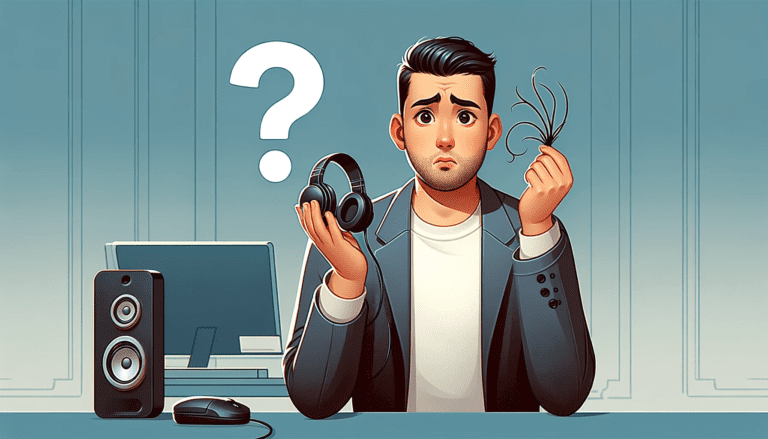Ever heard your favorite tunes through your headphones and wondered, “Could these delightful devices be harmful to my ears?” Here’s an eye-opening revelation for you. Yes, headphones can contribute to ear infections, but there’s more to it. Let’s unravel the connection together, shedding light on the hidden risks beyond just hearing loss.
“Understanding the health implications of regular headphone usage not only informs us, but also empowers us to take the necessary steps to protect our ears.”
This article unveils the silent culprits in your ear infections, busts common myths, shares reliable medical insights, and offers effective prevention tips. It also thoroughly explains how different types of headphones contribute differently to the issue all while keeping the experience of enjoying your music safe and uninterrupted.
So, let’s dive right in and turn the volume down on hidden headphone hazards.
Connection Between Headphones and Ear Infections
As far as the connection between headphones and ear infections goes, there are a few key angles to contemplate.
Firstly, headphones – and earbuds in particular – can create a moist, warm environment in your ear canal that’s ideal for bacteria. This is particularly true if you wear them for extended periods of time, preventing air circulation. Bacteria naturally exist in our ears, but when they multiply due to favorable conditions, an ear infection may result.
Secondly, poor cleaning habits can also be a contributing factor. If you fail to properly clean your headphones regularly, sweat, wax, and dead skin cells can build up on the surface. This gunk can then make its way into the ear where it can cause an infection.
Also, it’s worth mentioning that sharing headphones could expose you to someone else’s bacteria or even fungus. Hence, as innocent as it may seem, sharing headphones can potentially increase your risk of developing an ear infection.
Lastly, the type of headphones you use could pose a risk as well. For instance, in-ear headphones are most likely to create the unfavorable conditions described previously. Over-the-ear headphones, on the other hand, allow for better air circulation but they also need regular cleaning.
So, while headphones aren’t typically the direct source of an infection, they can certainly support an environment where potential ear problems thrive. You may read also Can You Wear Headphones with Hearing Aids
Headphones: Silent Culprit for Ear Infections?
Can you imagine a life without your favorite tunes buzzing in your ears? Headphones have become an integral part of our digital lives, whether it’s for work, entertainment, or blocking out the world around us. But are they as innocent as they seem, or can they contribute to a less-than-pleasant condition such as ear infections?
Let’s put it straight. Very few of us consider headphones as potential, albeit unintentional, perpetrators of ear infections. But in certain circumstances, they’ve been found to play a role. After prolonged or improper use, headphones can host bacteria and other microorganisms, providing them with a cozy passage straight into your ear canal. Now, combine these unwelcome guests with an unrecognized or untreated ear condition, and you might just be signing up for an ear infection.
It’s not just about bacteria either. You know that satisfying feeling of plugging in earbuds that fit your ears perfectly? Well, it might turn out to be a double-edged sword. When earbuds create an air-tight seal within your ear canal, they can unintentionally promote a humid, warm environment within your ear. This essentially acts as a micro-greenhouse, perfect for bacterial growth and propagation.
Note: While headphones may contribute to ear infections, they are certainly not the primary cause. The risk is particularly high for individuals with underlying conditions such as eczema of the ear canal, or those living in humid environments.
Our advice? Don’t banish your headphones just yet. Instead, arm yourself with the right information and headphone hygiene practices. After all, something that brings us so much joy can’t be all bad, right? Stay tuned, as later we’ll cover how to keep your headphones clean, and how to enjoy your music while keeping your ears safe.
Fact or Fiction: The Headphone-Ear Infection Link
Headphones have become an inseparable part of our daily routine, but can they really be blamed for ear infections? Let’s tune in to the facts to find out.
Typically, ear infections occur when bacteria or viruses infiltrate the middle ear, leading to symptoms like pain, discharge, and temporary hearing loss. There are numerous causes for these nasty bugs getting into your ear, and one potential doorway, as surprising as it may sound, is your beloved headphones.
Here’s why: Most often, the culprits are in-ear headphones or earbuds, which fit directly into your ear canal. By being in constant contact with this sensitive part of your ear, they can potentially introduce or promote the growth of harmful bacteria. Moreover, they also increase the temperature and humidity levels in your ears, which are perfect conditions for these bugs to thrive.
- Regular Use: The more often you use your headphones, the higher the chances of bacteria buildup on them. Especially if they stay in for extended periods, they can prevent necessary natural cleaning processes in your ears from occurring. It means your ears are exposed to bacteria for a longer duration.
- Shared Use: Don’t trade tunes with your friends by sharing earbuds. It’s not just your favorite songs you’re sharing but also a colony of bacteria unique to their ears.
However, it isn’t a completely one-sided story. Contrary to popular belief, only rarely do headphones cause infections. More often than not, they exacerbate an existing condition or introduce bacteria in already susceptible ears. If you regularly clean your ears, are cautious about what you put in them, and maintain hygiene, you reduce the risk significantly.
In a nutshell, headphones can contribute to ear infections, but they are hardly the sole cause. It is a combination of many factors, including personal hygiene habits, immune system strength, and overall ear health. People with conditions like swimmer’s ear or those prone to infections may have a higher risk.
To draw a line between fact or fiction on headphones causing ear infection, it’s somewhere in the middle, leaning towards fiction. While the potential is there, the risk is small if you are maintaining good ear hygiene.
In the next section, we’ll further delve into understanding how headphones contribute to ear infections and what you can do to mitigate these effects. But first, let’s tune out the fiction and focus on the fact that the risk is reduced dramatically if hygiene is maintained and headphones are used correctly. You may read the guide on Can Bone Conduction Headphones Cause Hearing Loss
Understanding How Headphones Contribute to Ear Infections
So, how exactly do headphones participate in the occurrence of ear infections? This is often a question that many of us ponder. The answer lies in understanding the environment of the ear canal and the role headphones play in it.
Our ear canals are often warm, dark, and moist. An ideal environment for the growth of bacteria and fungi. By wearing headphones for extended periods, not only do we maintain this moist environment, we might be introducing additional bacteria to our ear canals. Especially if the headphones are shared or not cleaned regularly.
Headphones, particularly in-ear ones, can sometimes cause minor abrasions in your ear canal. This is even more possible if you have a habit of frequently adjusting them or if they do not perfectly fit your ears. These small scrapes and cuts can create a gateway for bacteria to enter and cause an infection.
Furthermore, prolonged use of headphones can also lead to what doctors refer to as “swimmer’s ear”, an infection caused by trapped water or excessive moisture in the ear canal. This is because headphones block the normal aeration of the ear canal, disturbing its delicate ecology and natural self-cleaning mechanisms.
In essence, headphones may not directly cause ear infections, but they can create conditions conducive to microbial growth and potentially exacerbate pre-existing microscopic injuries within your precious ear canals.
If this sounds concerning, it’s important to highlight that all hope is not lost. There are several precautions and cleaning practices that you can adopt to reduce the risk of ear infections while still enjoying your favorite tunes. In the following sections, we’ll walk you through how to maintain the health of your ears while using headphones.
Prevention Tips: How to Avoid Ear Infections from Headphones
Headphones, which have become an essential part of our daily lives, can potentially pose a risk of developing ear infections if not used and maintained correctly. Now you might wonder, “How can I keep jamming to my favorite tunes without risking an ear infection?” Luckily, there are some simple measures you can take to minimize the risk – and we’ve got you covered.
Personal Hygiene: This might seem like common sense, but it’s incredibly important when it comes to avoiding ear infections. Make sure to clean your ears regularly, but avoid using cotton swabs or anything that can potentially push wax and debris deeper into your ear. A damp cloth to clean the outer area of your ear is usually sufficient.
Keep Them Clean: Just as you keep your ears clean, your headphones require cleaning too. Over time, they can collect dust, wax, and other debris that can create a breeding ground for bacteria. A gentle wipe with a soft, slightly damp cloth followed by drying should keep them clean.
Share Wisely: Sharing may be caring, but not so much when it comes to headphones. Sharing headphones can also mean sharing bacteria and potentially ear infections. If sharing is necessary, ensure they are properly cleaned before and after use.
Choose The Right Headphones: Some types of headphones are less likely to cause ear infections than others. Over-the-ear headphones are considered safer than in-ear headphones as they don’t go directly into your ear canal. Thus, they reduce the chance of trapping bacteria inside.
Give Your Ears A Break: Constant use of headphones can potentially create a warm, moist environment in your ears that bacteria can thrive in. Try to take breaks every now and then, allowing your ears to breathe.
Regulate Volume: While this might not directly prevent an ear infection, blasting your music too loudly can cause hearing damage over time. Remember, safety first!
By incorporating these simple practices into your routine, you can help keep your ears healthy and infection-free, while still enjoying your favorite music or podcasts. You may check also Do Noise-Canceling Headphones Protect Hearing
Types of Headphones and Their Link to Ear Infections
Each type of headphone, whether it be over-the-ear, on-ear, or in-ear, interacts with your ears in unique ways. This means that they can contribute differently to the development of ear infections.
Over-The-Ear Headphones: These headphones, also known as circumaural headphones, are designed to encompass your entire ear within their padding. A widespread belief is that they are the safest option for your ear health because they are away from your ear canal. However, they could still contribute to ear infections if they’re not cleaned regularly, as the padding can harbor bacteria over time.
In-Ear Headphones:
Also known as earbuds, these fit directly into your ear canal. While they provide an immersive sound experience, they pose a higher risk for ear infections. Earbuds are exposed to bacteria from the environment, and simultaneous use also blocks the natural air flow leading to a warm, moist environment in your ear – a perfect condition for bacterial growth.
On-Ear Headphones: These headphones, also called supra-aural headphones, sit directly on top of your ears without enclosing them fully. They share similar risks with over-the-ear headphones as they’re also prone to bacteria buildup over time. However, they’re slightly better in allowing for some air circulation.
Wireless headphones, regardless of their design, can potentially carry an additional risk factor. Many users often forget to clean their devices, and then place them back in their charging case. Unbeknownst to them, those cases can also be a breeding ground for bacteria, heightening chances for ear infections.
It’s crucial to understand that all headphones can potentially contribute to ear infections if not adequately cleaned or used excessively. The next section will highlight the steps to properly care for and clean your headphones to maintain ear health.
Mitigating the Risk: Proper Care and Cleaning of Headphones
Let’s face it, your headphones can easily turn into a breeding ground for bacteria, leading to the potential risk of ear infection if not handled with care. But don’t fret – there are simple steps you can follow to maintain your cherished headphones and safeguard your ear’s health.
The key is consistency in cleaning:
- Routine cleaning: Get into the habit of wiping down your headphones after use with a soft, dry cloth.
- Deep cleaning: Every week or so, depending on usage, give your headphones a more thorough cleanup. If your headphones have removable parts, such as earbuds, make sure to take these pieces apart before you start the deep cleaning process.
- Use the right tools: Use gentle cleaning solutions that won’t damage the material of your headphones. For in-ear headphones, consider using a small brush (a toothbrush could do the trick) to reach those tiny corners.
Remember, sharing is not caring when it comes to headphones. By letting others use your headphones, you’re not only sharing your music but also a host of tiny bacteria. Always stick to using your own pair and prevent sharing as far as possible.
Just as you wouldn’t use dirty dishware, treat your headphones with the same respect and cleanliness. Your ears will thank you!
| Cleaning Steps | Cleaning Frequency | Tools Required |
|---|---|---|
| Routine Cleaning | After every use | Soft, Dry Cloth |
| Deep Cleaning | Once a week | Gentle Cleaning Solution, Small Brush |
Remember: It’s not just about the type of headphones you use or how long you use them, it’s also about the care and cleanliness you maintain!
Debunking Myths: Can Headphones Really Cause Ear Infections?
It’s not uncommon to hear people wondering, “Can headphones really cause ear infections?” This question often emerges due to various myths and misconceptions prevalent among music enthusiasts and audiophiles alike. Let’s tease apart reality from fiction.
Myth #1: “Sharing headphones can’t spread ear infections.”
The truth? It can. To put it simply, germs love to travel. When you share headphones, you’re potentially sharing bacteria and even earwax (yuck!) too. This can potentially lead to an ear infection. So, if you’re in the habit of swapping earbuds with friends, it’s time to rethink that approach.
Myth #2: “Dirty headphones don’t cause ear infections.”
Again, this isn’t true. In fact, the buildup of earwax and dirt on your headphones not only damages the quality of your audio experience but can also lead to bacterial growth. If this bacteria gets into your ear, it can cause an infection. So, keeping your headphones clean is incredibly important.
Myth #3: “In-ear headphones are more likely to cause infections than over-ear headphones.”
There is some truth to this one. While the type of headphones you use doesn’t directly cause an ear infection, in-ear variants can increase the chances. This is because they sit directly in the ear canal, and hence, are more likely to introduce harmful bacteria into the ear. This doesn’t mean that over-ear headphones are entirely risk-free though. It’s very much a matter of hygiene and proper care.
Let’s sum up: Rather than the headphones themselves, it’s generally poor hygiene and lack of proper cleaning that can lead to ear infections. The key to safe headphone use is regular cleaning and personal use. Now, let’s move forward with how to keep them squeaky clean!
Medical Insights: What Doctors Say About Headphones and Ear Infections
When it comes to the connection between headphones and ear infections, the medical community has some interesting insights to share. Although doctors generally agree that headphones are not inherently harmful, how they are used can potentially lead to ear complications.
One key point that many doctors emphasize is the importance of cleanliness. Dr. Robert Puchalski, an experienced otolaryngologist, observes:
“Earbuds can be a breeding ground for bacteria if not properly cleaned. This bacteria can then be transferred into the ear, leading to infections.”
Additionally, specialist in audiology Dr. Ruth Bentler points out that the prolonged use of headphones, especially at high volumes, can potentially lead to other ear-related issues such as tinnitus or even hearing loss.
It’s not only about the physical impact. Dr. James Battey, a renowned neurologist, highlights that symptoms of ear infections, such as pain or a feeling of fullness in the ear, can be exacerbated by the constant use of headphones, particularly in-ear varieties, as they can cause irritation and swelling in the ear canal. This can trap bacteria and increase the risk of developing an infection.
However, it’s worth highlighting the key takeaway from many medical practitioners: proper hygiene and responsible use can significantly mitigate these risks associated with headphones. Cleaning your headphones regularly, and keeping volumes to a safe level, can help you enjoy your music while also safeguarding your ear health.
Ultimately, while there is a link between headphones and ear infections, it’s clear that a little care and attention can make a world of difference. You may check also Do Headphones Cause Hair Loss
User’s Guide: Safely Enjoying Your Headphones Without Risk to Your Ears
So, you love your headphones and can’t imagine a day without them, can you? Well, you’re certainly not the only one. But there’s no reason why this love affair should come at the expense of your ear health. Luckily, it doesn’t have to. With a few simple measures and a bit of vigilance, you can still enjoy your tunes without putting your ears at risk.
Here’s a guide to help you do just that.
- Adopt an ‘everybody for their own’ approach: It’s not just about protecting your ears. It’s about protecting everybody’s ears. Sharing headphones can introduce foreign bacteria or fungi into your ears. So, if you wouldn’t share your toothbrush, why share your headphones?
- Be a cleanliness freak: Okay, maybe not a freak, but you do need to clean your headphones regularly. Wipe them down with alcohol-based wipes, particularly the earbuds. And remember, just because your headphones look clean doesn’t mean they are.
- Maintain some dry time: Ears need airflow to stay healthy. Constantly wearing a pair of in-ears can cause excess moisture build-up. This can create a perfect breeding ground for infection. So, try to remove your in-ears every now and then to let your ears breathe (and dry out).
- Take a volume check: Turning the volume up too high can lead to noise-induced hearing loss. Always make sure to keep the volume at a safe level – ideally, no more than 60% of the full volume.
- Choose the right headphones: Over-ear headphones are often a safer choice, as they don’t directly enter the ear canal. They are less likely to cause excess moisture and are typically easier to clean.
Remember, it’s all about balance. The right habits can ensure your headphone usage remains a source of pleasure, not discomfort. Your ears are precious – treat them that way! You may see also Can Headphones Cause Tinnitus
Sound Safety: How to Balance Enjoyment of Music with Ear Health
When it comes to enjoying your favorite tunes, your health isn’t something you’d typically factor in. Surprisingly, your headphones, a seemingly innocuous gadget, could pose a risk to your ear health if not used wisely. So, how do you keep your ears safe while still vibing to your most loved songs without worries? Don’t fret; we’ve got you covered.
Firstly, and most simply, moderate your listening volume. The louder the sound, the more strain you’re putting on your eardrum. Save your ears undue stress by keeping the volume at a maximum of 60% of the total, and try not to listen for longer than 60 minutes at a time – often referred to as the 60/60 rule. This practice can prevent potential damage to your inner ear and a resulting infection.
Choosing the right headphones also plays a pivotal role in ensuring safe listening. As we’ve discussed earlier, different types of headphones, such as over-ear and in-ear headphones, can influence the chances of getting an ear infection. Pick an option that you are comfortable with and that suits your lifestyle, but also consider the hygiene factors associated with your choice.
Maintaining an ear-friendly cleanliness routine can be another game-changer. Ensure you regularly clean and disinfect your headphones, since they come into direct contact with your ear canal and could easily harbor infectious bacteria. Diligent and regular cleaning can help eliminate this risk.
Lastly, share your music, not your headphones. Sharing headphones increases the risk of transferring bacteria from one ear to another. Being keen about who uses your headphones can drastically lower the chance of contracting an ear infection.
In essence, balancing the blissful enjoyment of music with maintaining a healthy pair of ears isn’t as hard as it seems. It’s all about being aware, staying disciplined, and taking these relatively simple precautions. Happy listening!
Conclusion
In conclusion, headphones can potentially lead to ear infections if not used and maintained correctly. This risk can be considerably mitigated by regular cleaning, avoiding sharing headphones and taking breaks during prolonged use. However, it’s important to note that headphones are not an outright cause of ear infections but can only act as a conduit in certain conditions.
Always prioritize ear health while enjoying your music and consult with a healthcare professional if you suspect any signs of an ear infection. Ultimately, safe and responsible headphone use is key.







